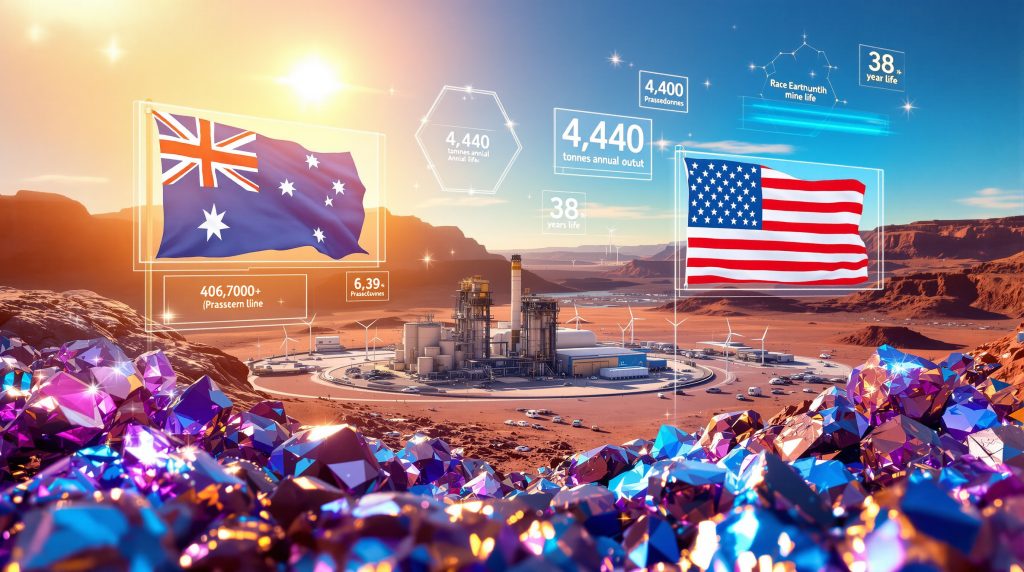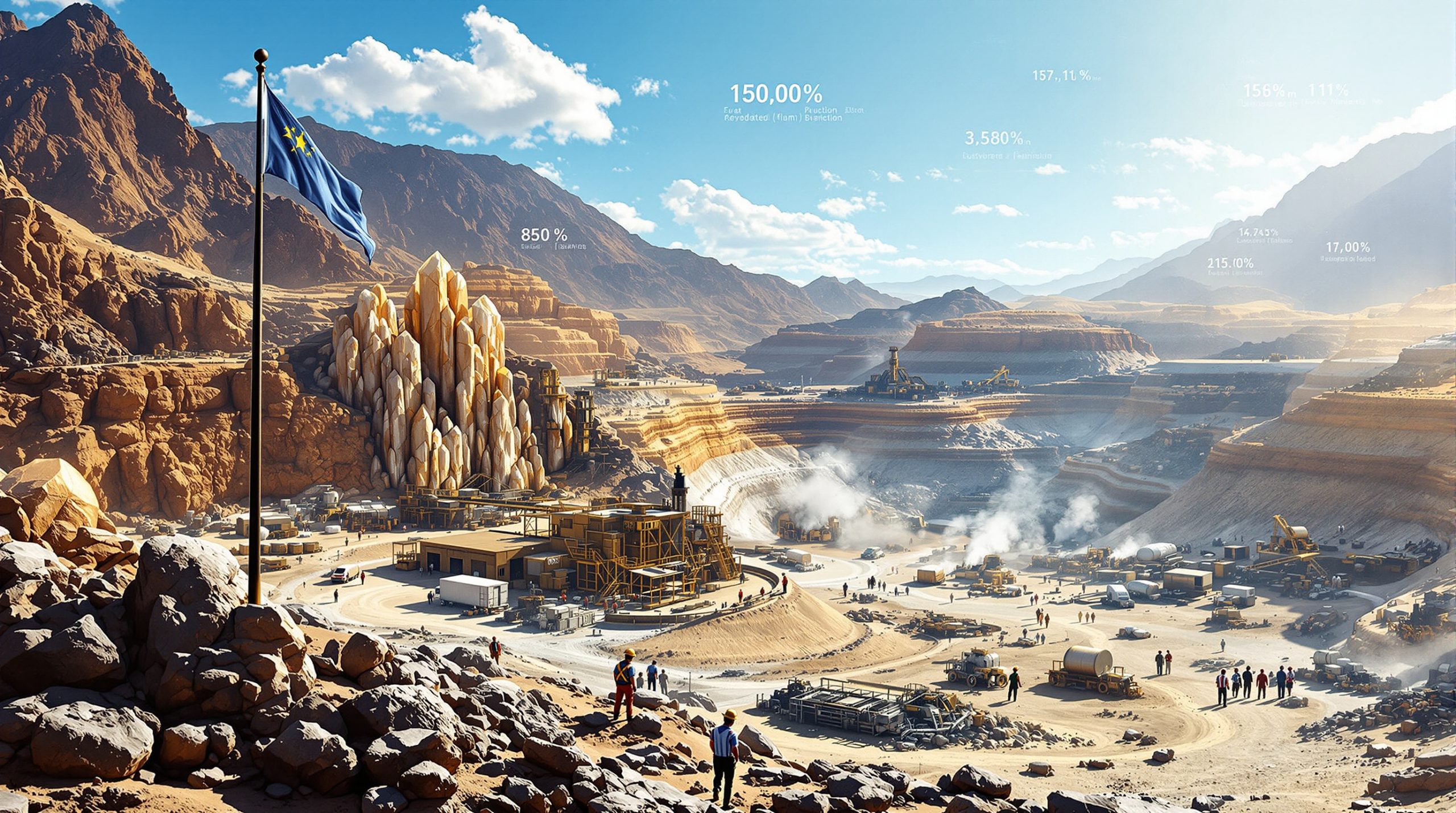Strategic Financing Transforms Critical Minerals Development
The global transition toward renewable energy technologies has fundamentally altered how governments approach strategic mineral investments. Arafura Rare Earths funding represents a pivotal example of this transformation, where traditional mining finance models have evolved to incorporate national security considerations alongside commercial viability. This shift reflects growing recognition that rare earth supply chains require coordinated international support to reduce dependency on Chinese-dominated processing networks.
Government-backed financing initiatives now prioritise projects capable of delivering processed rare earth oxides directly to Western manufacturers. The Northern Australia Infrastructure Facility, Export Finance Australia, and bilateral cooperation frameworks have emerged as essential components of this strategic approach, providing concessional financing terms that reflect the broader economic and security benefits of domestic rare earth processing capabilities.
Multi-Agency Coordination Framework
Australia's critical minerals strategy involves multiple government entities working in coordination with international partners. The Northern Australia Infrastructure Facility operates under the Northern Australia Infrastructure Facility Act 2016, providing concessional financing specifically designed to unlock economic development opportunities in northern Australia. This facility targets infrastructure projects that generate broader regional economic benefits beyond traditional commercial returns.
Export Finance Australia serves as the nation's export credit agency, offering financing solutions that support Australian businesses in international markets. When combined with international cooperation agreements, these agencies create comprehensive funding packages that address both commercial and strategic objectives. The coordination between Australian and American financial institutions represents a new model for allied cooperation in critical minerals development.
Technical Excellence Drives International Investment Appeal
The Nolans Project distinguishes itself through its integrated mine-to-oxide processing model, eliminating traditional dependencies on Chinese separation facilities. This operational approach enables direct supply to magnet manufacturers without intermediate processing steps that have historically concentrated in China. The project's annual production target of 4,440 tonnes of neodymium-praseodymium oxide positions it as a significant contributor to global supply diversification efforts.
Located 135 kilometers north of Alice Springs in Australia's Northern Territory, the project benefits from established transportation infrastructure including the Adelaide-Darwin railway line. This geographic advantage reduces capital requirements compared to remote mining operations that require extensive infrastructure development. The proximity to existing power and transportation networks creates operational efficiencies that enhance project economics and reduce construction timelines.
Processing Technology Advantages
The integrated processing facility at Nolans incorporates hydrometallurgical technologies that enable direct conversion of rare earth ores into high-purity oxides suitable for magnet manufacturing. This eliminates the traditional model where rare earth concentrates are shipped to China for separation and refining before returning to Western markets as finished products.
The project's processing capabilities extend beyond standard light rare earth production, with potential development of heavy rare earth processing expertise. While the facility may not exploit heavy rare earth elements at commercial scale initially, the technical knowledge gained positions the operation as a potential toll processing centre for other regional deposits requiring specialised separation capabilities.
Key Technical Specifications:
- Annual NdPr oxide production capacity: 4,440 tonnes
- Projected operational lifespan: 38 years
- Processing method: Integrated hydrometallurgical separation
- Product specifications: Magnet-grade rare earth oxides
- Geographic advantages: Established infrastructure access
Comprehensive Funding Package Exceeds One Billion Dollars
Arafura Rare Earths funding has evolved into a sophisticated multi-source financing structure combining government support with private sector participation. The US$300 million Letter of Interest from the U.S. Export-Import Bank represents the latest addition to an existing US$1.05 billion debt package, demonstrating the project's ability to attract substantial institutional support.
The non-binding nature of the EXIM Letter of Interest reflects standard procedures for large-scale project financing, where preliminary commitments undergo detailed due diligence before converting to binding agreements. This process involves coordination between the Export-Import Bank of the United States and Export Finance Australia under a Single Point of Entry framework designed to streamline international cooperation. For more details on this financing arrangement, investors can review the US EXIM loan details which provide insight into similar government-backed funding structures.
Government Financial Commitments Structure
| Funding Source | Amount | Type | Status |
|---|---|---|---|
| US Export-Import Bank | US$300 million | Letter of Interest | Non-binding |
| Existing debt package | US$1.05 billion | Multiple sources | Arranged |
| Northern Australia Infrastructure Facility | Debt financing | Concessional terms | Committed |
| Export Finance Australia | Co-financing | Coordination role | Active |
The financing structure incorporates both debt and equity components, with government agencies providing concessional terms that reflect the strategic value of secure rare earth supplies. Cost overrun facilities and contingency funding mechanisms provide additional financial security for lenders and equity investors, reducing project risk profiles compared to traditional mining developments.
Conversion Timeline and Conditions
Converting the Letter of Interest into binding financing commitments requires satisfaction of multiple conditions precedent. These include completion of environmental and social due diligence meeting EXIM standards, coordination with Australian co-financing partners, and final credit underwriting approvals. The timeline for this conversion typically extends 12-18 months from initial LOI issuance, depending on project complexity and regulatory requirements.
Allied Cooperation Reshapes Critical Minerals Finance
The October 2025 U.S.-Australia cooperation framework has allocated substantial resources toward joint critical minerals development initiatives. This bilateral approach recognises that secure rare earth supplies require coordinated investment from allied nations to establish viable alternatives to Chinese-dominated supply chains.
Under the Trump administration's continuation of critical minerals policies, the U.S. Export-Import Bank has prioritised projects capable of supplying American defence contractors and clean energy manufacturers. Chairman John Jovanovic emphasised that the initiative strengthens national security while bolstering supply chain resilience for technologies essential to American competitiveness. Furthermore, the US critical minerals order has reinforced these strategic priorities.
Supply Chain Resiliency Initiative Framework
The EXIM financing operates under the Supply Chain Resiliency Initiative, which prioritises projects that demonstrate capability to supply U.S. manufacturers with non-Chinese rare earth inputs. This framework evaluates projects based on their contribution to supply chain diversification rather than purely commercial metrics, enabling support for strategically important developments that might not qualify under traditional financing criteria.
The initiative creates pathways for allied nations to access American financial support for critical minerals projects, provided they meet specific criteria for supply chain integration and strategic value. This approach extends beyond traditional export credit models to encompass broader national security and economic competitiveness objectives.
Bilateral Cooperation Benefits:
- Coordinated government financial support
- Streamlined regulatory approvals across jurisdictions
- Enhanced market access for processed materials
- Technology sharing and expertise development
- Risk mitigation through allied partnership
Strategic Partnerships Secure Long-Term Revenue Streams
Arafura has established binding offtake agreements with major automotive and renewable energy manufacturers, providing revenue certainty essential for project financing. Hyundai Motor Group and Kia Corporation have committed to purchase substantial portions of the project's output, reflecting the automotive industry's urgent need for secure rare earth supplies outside Chinese control.
Siemens Gamesa represents the renewable energy sector's participation in supply chain diversification efforts, securing rare earth inputs for wind turbine manufacturing. These agreements typically include volume commitments, pricing mechanisms linked to market indices, and quality specifications that ensure product suitability for high-performance applications.
Automotive Industry Supply Chain Strategy
The automotive sector's transition to electric vehicles has created unprecedented demand for high-strength permanent magnets containing neodymium and praseodymium. Traditional supply chains routing through Chinese processing facilities present strategic vulnerabilities for manufacturers seeking to diversify procurement sources. Arafura's integrated processing capabilities enable direct supply to automotive manufacturers without intermediate Chinese processing steps.
These partnerships extend beyond simple commodity purchasing agreements to encompass technical cooperation and product development initiatives. Automotive manufacturers require consistent quality and specifications for rare earth inputs, necessitating close coordination between producers and end-users throughout the development process.
Confirmed Offtake Partners:
- Hyundai Motor Group: Long-term supply agreement for NdPr oxides
- Kia Corporation: Binding commitment for electric vehicle manufacturing
- Siemens Gamesa: Renewable energy sector rare earth requirements
- Additional partnerships: Under negotiation across multiple sectors
Phase Two Expansion Could Transform Global Market Position
Industry analysis suggests potential acceleration of Phase 2 development could scale Arafura's annual production to approximately 11,000 tonnes, positioning the company among the world's largest non-Chinese rare earth producers. This expansion scenario, based on investor projections rather than official company guidance, could generate annual revenues approaching $2 billion at current market prices.
Such scaling would require substantial additional capital investment, expanded processing facilities, and securing adequate rare earth reserves or toll processing arrangements to support increased throughput. The economic viability of this expansion depends on sustained demand growth from electric vehicle and renewable energy markets, along with continued price stability for rare earth oxides.
Processing Capability Development
The potential expansion includes development of heavy rare earth element processing capabilities, though commercial-scale heavy rare earth production may not be economically viable initially. Instead, the facility could serve as a toll processing centre for other regional deposits requiring specialised separation expertise, creating additional revenue streams while building technical competencies. This aligns with broader renewable energy mining developments across the industry.
This approach reflects broader industry trends toward regional processing hubs that serve multiple mining operations rather than each project developing independent processing capabilities. The model reduces capital requirements for individual mining projects while creating economies of scale in processing operations.
Phase 2 Expansion Projections:
- Potential annual production: 11,000 tonnes NdPr oxide
- Estimated annual revenues: $2 billion (market dependent)
- Additional processing capabilities: Heavy rare earth elements
- Toll processing opportunities: Regional hub development
- Competitive positioning: Leading ex-China producer
Disclaimer: Expansion projections represent industry speculation and investor estimates rather than official company guidance. Actual results may differ materially based on market conditions, regulatory approvals, and technical execution.
Environmental Standards Drive Green Finance Integration
Arafura Rare Earths funding incorporates Environmental, Social, and Governance principles through specialised financing structures that align project development with international sustainability standards. Green finance mechanisms provide preferential terms for projects demonstrating positive environmental and social outcomes, reflecting investor demand for responsible mining practices.
The project's focus on supplying materials for electric vehicles and renewable energy systems positions it within the broader clean technology ecosystem. This alignment enhances access to climate-focused investment capital while meeting increasingly stringent ESG requirements from institutional investors and government agencies.
Sustainability Framework Implementation
Rare earth mining operations face unique environmental challenges related to radioactive material management and complex chemical processing requirements. The Nolans Project incorporates advanced tailings management systems and water recycling technologies designed to minimise environmental impact while maintaining operational efficiency.
Indigenous engagement and traditional owner agreements represent critical components of the project's social licence to operate in Australia's Northern Territory. These arrangements ensure appropriate consultation and benefit-sharing with Aboriginal communities while respecting cultural heritage considerations throughout project development.
ESG Integration Elements:
- Advanced tailings storage facility design
- Water recycling and management systems
- Radioactive material handling protocols
- Indigenous community engagement programmes
- Rehabilitation and closure planning
Development Risks Could Affect Implementation Timeline
Converting non-binding financing commitments into definitive agreements requires navigating complex regulatory frameworks across multiple jurisdictions. The coordination between American and Australian agencies adds procedural complexity that could extend funding finalisation timelines beyond initial expectations.
Market volatility in rare earth pricing presents ongoing challenges for project economics and investor confidence. However, long-term supply agreements with established offtake partners and substantial government backing provide significant protection against commodity price fluctuations compared to merchant market exposure.
Technical and Operational Challenges
Construction cost inflation in the Australian mining sector has impacted project economics across the industry, requiring careful management of capital expenditure budgets and construction timelines. Labour availability in Australia's Northern Territory presents additional challenges for large-scale construction projects, necessitating workforce development initiatives and accommodation infrastructure.
The complexity of hydrometallurgical processing for rare earth separation introduces technical risks that require specialised expertise and proven technology deployment. While the processing methods are well-established, successful implementation requires careful attention to process optimisation and quality control systems.
Key Risk Factors:
- Regulatory coordination across jurisdictions
- Construction cost inflation management
- Skilled labour availability in remote locations
- Technology implementation and optimisation
- Market price volatility impacts
Recent share price performance has reflected renewed investor optimism following the EXIM Letter of Interest announcement, with technical analysis indicating sustained momentum above A$0.25 resistance levels. However, sustained gains depend on successful conversion of financing commitments and achievement of construction milestones at the Nolans site.
International Investment Patterns Reflect Strategic Priorities
Government support for rare earth projects has emerged as a global trend among Western nations seeking to establish domestic critical minerals capabilities. The United States, Canada, and European Union have implemented various support mechanisms ranging from direct grants to export credit facilities, reflecting recognition that strategic materials require public sector involvement.
Traditional mining finance models prove insufficient for rare earth projects due to processing complexity, extended development timelines, and geopolitical considerations surrounding supply chain security. Government participation reduces private sector risk while ensuring strategic supply chain objectives receive appropriate priority alongside commercial returns.
Comparative International Approaches
The U.S. Department of Defence has allocated substantial funding through Defence Production Act authorities to support domestic rare earth processing capabilities. Similar initiatives in Canada focus on northern development opportunities, while European programmes emphasise supply chain resilience for renewable energy technologies.
These programmes share common characteristics including government risk-sharing, strategic supply chain objectives, and coordination with allied nations to create comprehensive alternatives to Chinese-dominated markets. The scale of public sector involvement reflects the strategic importance attributed to secure critical minerals supplies. Additionally, the Northern Territory's investment framework demonstrates Australia's commitment to developing these critical capabilities.
Global Government Support Mechanisms:
- U.S. Defence Production Act Title III investments
- Canadian Natural Resources Critical Minerals Strategy
- European Union Critical Raw Materials Act initiatives
- Australian Northern Territory development programmes
- Export credit agency coordination frameworks
Australian Economic Development and Strategic Capabilities
Successful implementation of the Nolans Project would create over 600 construction jobs and 350 permanent operational positions in the Alice Springs region, generating substantial economic activity in Australia's Northern Territory. This employment creation supports broader regional development objectives while establishing rare earth processing expertise within Australian industrial capabilities.
The project's contribution to Northern Territory economic development extends beyond direct employment to include skills development, infrastructure investment, and supply chain opportunities for regional businesses. Royalty payments to the territorial government provide ongoing revenue streams supporting public services and further economic development initiatives.
National Security and Industrial Capability
Australia's development of domestic rare earth processing capabilities addresses strategic vulnerabilities in defence supply chains while supporting export opportunities to allied nations. The integrated processing model ensures that Australia captures value-added activities rather than simply exporting raw materials for overseas processing.
This capability development aligns with broader AUKUS cooperation objectives and Australia's role in supporting allied technology development programmes. Access to processed rare earth oxides supports domestic manufacturing initiatives while providing export revenue opportunities in growing international markets.
Economic and Strategic Benefits:
- Regional employment creation: 950+ total jobs
- Skills development and training opportunities
- Northern Territory royalty revenue generation
- Strategic supply chain capability development
- Export revenue from allied nation sales
- Defence supply chain security enhancement
Critical Questions for Investors and Stakeholders
Final Investment Decision Status and Timeline
As of late 2025, Arafura continues working toward Final Investment Decision following recent funding commitments and financing arrangements. The timeline for FID depends on completing remaining conditions precedent, including conversion of the EXIM Letter of Interest to binding commitment and finalisation of construction contracts with major engineering firms.
The company has indicated that achieving FID represents the culmination of extensive development work and provides the foundation for commencing construction activities at the Nolans site. Meeting this milestone triggers access to committed financing facilities and enables progression to operational readiness.
U.S. Financing Participation Impact
The project maintains financial viability through existing Australian government commitments and private sector arrangements, though U.S. participation would significantly enhance development timelines and market positioning. American involvement provides additional funding while opening access to U.S. markets and downstream partnerships.
The symbolic value of U.S. government backing extends beyond financial contribution to encompass strategic validation of Arafura's role in allied supply chain diversification efforts. This positioning could facilitate additional partnerships and market opportunities as Western governments prioritise secure critical minerals sources.
Market Position and Competitive Dynamics
Successful project implementation would position Arafura among the world's largest non-Chinese rare earth producers, competing directly with established operations including MP Materials in the United States and Lynas Corporation's Malaysian processing facilities. The integrated mine-to-oxide model provides competitive advantages through reduced processing costs and enhanced supply chain control.
Long-term competitiveness depends on maintaining cost efficiency, product quality, and customer relationships while navigating evolving market dynamics and potential new entrant competition. The company's strategic partnerships and government backing provide significant competitive advantages in securing market share within growing rare earth demand.
Investment Disclaimer: The information contained in this analysis does not constitute financial advice. Past performance does not guarantee future results. Investors should conduct their own due diligence and consider consulting qualified financial advisors before making investment decisions. Rare earth markets involve significant volatility and operational risks that could materially impact investment outcomes.
Looking to Capitalise on Strategic Critical Minerals Investments?
Discovery Alert's proprietary Discovery IQ model delivers instant notifications on significant ASX mineral discoveries, including rare earth and critical minerals projects that often attract substantial government backing and strategic partnerships. Discover how major mineral announcements can generate exceptional returns by exploring Discovery Alert's dedicated discoveries page, then begin your 30-day free trial to position yourself ahead of the market on the next transformative discovery.




